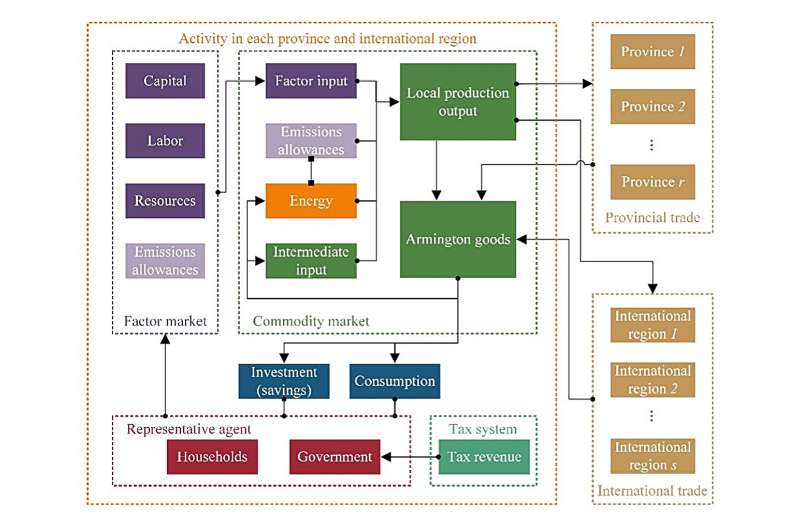This article has been reviewed according to Science X's editorial process and policies. Editors have highlighted the following attributes while ensuring the content's credibility:
fact-checked
proofread
A CGE model for provincial analysis of China's carbon neutrality target

Computable General Equilibrium (CGE) models have become increasingly prevalent, offering valuable insights into the complex and interconnected economic and environmental impacts of climate mitigation strategies. The China Regional Energy Model (C-REM) is a recursive-dynamic, multi-sector, multi-regional CGE model extensively used in modeling China's energy and climate policies, focusing on the distribution of effects across provinces.
The development team of C-REM from Tsinghua University and Massachusetts Institute of Technology recently outlined the model's historical applications, described the modeling methods used in its newly updated version, and illustrated its features by showing illustrative simulation results for China's carbon neutrality target. It can help foster transparency and knowledge sharing within the community of CGE modelers and researchers in the field of climate policies.
The team published their review in Energy and Climate Management.
"C-REM aims to assess the impacts of China's existing and prospective carbon emissions reduction targets, propose methods for distributing the national target to the provincial level, evaluate different emissions reduction actions, and finally provide well-founded policy recommendations," said Da Zhang, corresponding author of the paper, associate professor in the Institute of Energy, Environment and Economy at Tsinghua University.
The team presents an overview of the evolution and historical applications of the C-REM. From the initial static version, the C-REM model has gradually expanded to a recursive dynamic model and integrated with other models (such as the atmospheric chemistry transport model) to assess the economic and environmental impacts of climate policies comprehensively. The C-REM model has been applied to the provincial impact assessment of climate policy in China, the analysis of interprovincial migration impact on climate policy, and the co-benefits of climate policy on air quality and human health.
The model has been updated to the 4.0 version to address long-term emissions reduction challenges, such as how to achieve the carbon neutrality target. "We updated the model with 2017 as the base year and extended the projection horizon to 2060. We also introduced carbon capture and storage (CCS) technologies into the model, recognizing the growing importance of negative emissions technologies in realizing carbon neutrality," said Da Zhang.
The modeling methods used in the C-REM 4.0 are described in detail, including the model sectors and regions, data preparation procedures, representation of the economic activities of different sectors, climate policy simulation methods, dynamic process, and programming implementation.
An illustrative example of applying the updated model is provided under the context of the carbon neutrality target in China.
"We find that the 2060 carbon neutrality target will lead to a lower and earlier peak in total primary energy consumption with a transition towards non-fossil energy sources compared to the prior target, which focused only on the timing of the carbon peak. Our scenarios further suggest that the electricity and metal smelting sectors are the main contributors to CO2 reduction between 2025 and 2060.
"Assuming the current effort-sharing principle continues to be used for emissions reduction target allocation among provinces, more developed provinces and provinces that rely more on fossil-based energy will bear higher costs in a net zero energy transition. Certain northwest provinces are projected to experience positive impacts due to industry relocation, driven by abundant renewable resources and carbon storage capacity," said Da Zhang.
The research team expects the paper to guide model users and spur further development of CGE modeling in China. Da Zhang said, "The C-REM 4.0 is well-equipped for future applications in climate policy analysis under China's carbon neutrality target. We expect to link our model further with other models, such as earth system models, to capture the environment and climate feedback on the human system. We also plan to use the updated model to explore more alternative policy designs in greater detail toward carbon neutrality."
Other contributors include Hantang Peng, Chenfei Qu from the Institute of Energy, Environment and Economy at Tsinghua University, and Valerie J. Karplus from the Department of Engineering and Public Policy at Carnegie Mellon University.
More information: Hantang Peng et al, The C-REM 4.0 model: A CGE model for provincial analysis of China's carbon neutrality target, Energy and Climate Management (2024). DOI: 10.26599/ECM.2024.9400006
Provided by Tsinghua University Press



















